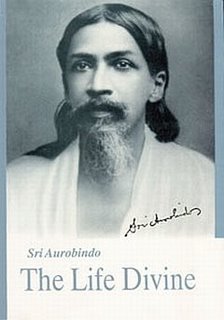 |
Mind and Supermind
AVIDYA – THE SELF-IGNORING FACULTY
Sri Aurobindo describes how multiple divisible forms exist in the same matrix of Prakriti or Nature though each form is presided by a distinct Purusha while all the myriad Purushas are delegates of the One Supreme Self. Yet in spite of the fact that multiple Purushas are derived from the same Self, the very existence of the multiplicity of forms points to an inevitable depiecing ‘as if’ they represented separate islands of consciousnesses. To the Divine Soul however the unitary truth of existence is not lost, ‘it does not forfeit its unity: it uses mind as a subordinate action of the infinite knowledge, a definition of things subordinate to its awareness of infinity, a delimitation dependent on its awareness of essential totality – not that apparent and pluralistic totality of sum and collective aggregation which is only another phenomenon of Mind. Thus there is no real limitation; the soul uses its defining power for the play of well-distinguished forms and forces and is not used by that power’ (The Life Divine, pg 179).
|
|
The pertinent query is how the inevitable unity permeating all existence translates itself into a divisibility of forms. Obviously any action requires energy for effectuation and the endless divisibility of what in essence is a Supreme Oneness must need a very specialized and distinctive action of the ‘conscious-force’ or Shakti aspect of the Absolute. Sri Aurobindo describes this specialized action of conscious-force as the ‘SELF-IGNORING FACULTY’ or ‘AVIDYA’. He describes the metapsychology of Avidya in lucidly moving terms:
‘A new factor, a new action of conscious force is therefore needed to create the operation of a helplessly limited as opposed to freely limiting mind, -- that is to say, of mind subject to its own play and deceived by it as opposed to mind master of its own play and viewing it in its truth, the creature mind as opposed to the divine. That new factor is Avidya, the self-ignoring faculty which separates the action of the mind from the action of the Supermind that originated and still governs it from behind the veil. Thus separated, Mind perceives only the particular and not the universal, or conceives only the particular in an unpossessed universal and no longer both particular and universal as phenomena of the Infinite. Thus we have the limited mind which views every phenomenon as a thing-in-itself, separate part of a whole which again exists separately in a greater whole and so on, enlarging always it aggregates without getting back to the sense of a true infinity’ (Ibid, pg 179-180).
‘A new factor, a new action of conscious force is therefore needed to create the operation of a helplessly limited as opposed to freely limiting mind, -- that is to say, of mind subject to its own play and deceived by it as opposed to mind master of its own play and viewing it in its truth, the creature mind as opposed to the divine. That new factor is Avidya, the self-ignoring faculty which separates the action of the mind from the action of the Supermind that originated and still governs it from behind the veil. Thus separated, Mind perceives only the particular and not the universal, or conceives only the particular in an unpossessed universal and no longer both particular and universal as phenomena of the Infinite. Thus we have the limited mind which views every phenomenon as a thing-in-itself, separate part of a whole which again exists separately in a greater whole and so on, enlarging always it aggregates without getting back to the sense of a true infinity’ (Ibid, pg 179-180).
The term ‘Avidya’ literally is translated as ignorance, albeit, the Great Ignorance. It is knowledge of the multiplicity that has lost the memory of the all pervading ethereal unity that permitted the multiplicity. It is the knowledge that gives us the marvels of science, the satisfaction of logical reasoning, the basis of our materialistic culture, the supremacy of economic ordering, the pleasure of hedonism, the passion of the die-hard votary of a cult, religion or social class or for that matter of a classless society. Thus Avidya is not the ignorance as we interpret it in terms of whatever lacks knowledge. It is in fact a specialized knowledge, so specialized as to lose touch with the unitary essence. Sri Aurobindo translates and defines Avidya not merely as Ignorance but as a ‘self-ignoring faculty’. This definition automatically implies that it is a specialized faculty sanctioned by the Supermind for dissociating the mind from the Supermind. This is why it has been repeated again and again in the traditional scriptures that through Ignorance, one has to wend one’s way to the Knowledge. We start from the multiplicity as apparently separate units and move towards an unity that simultaneously includes and surpasses the multiplicity while yet sustaining it in and through the secret soul-substance.
Date of Update:
28-Nov-16
- By Dr. Soumitra Basu
|

